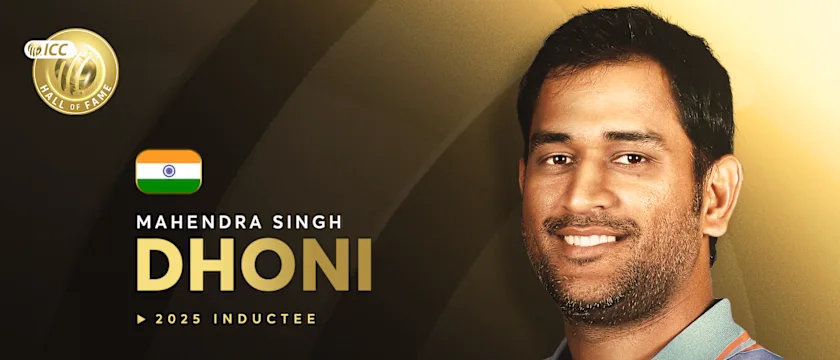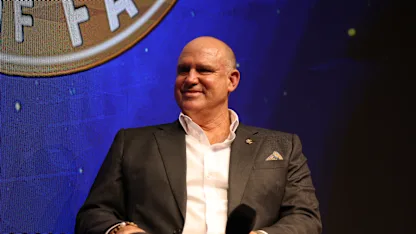MS Dhoni: A captain, wicketkeeper and batter beyond numbers
A captain, batter and wicket-keeper par excellence, MS Dhoni has become one of the latest inductees into the ICC Hall of Fame.
Celebrated not just for his calm under pressure and unmatched tactical nous, but also a trailblazer in the shorter formats, MS Dhoni’s legacy as one of the game’s greatest finishers, leaders and wicketkeepers has been honoured with his induction into the ICC Cricket Hall of Fame.
With 17,266 international runs, 829 dismissals and 538 matches across formats for India, Dhoni’s numbers reflect not just excellence but extraordinary consistency, fitness and longevity.
Gallery
Reacting to his presence in the august company, the former India skipper stated that this honour would stay with him forever.
"It is an honour to be named in the ICC Hall of Fame, which recognises the contributions of cricketers across generations and from all over the world. To have your name remembered alongside such all-time greats is a wonderful feeling. It is something that I will cherish forever."
India’s Captain Cool | MS Dhoni | ICC Hall of Fame
"Whenever you played against him, you knew the game was never over until he was out!". Cricket greats celebrate MS Dhoni, one of the newest inductees in the ICC Hall of Fame.
The anomaly that took Indian cricket by storm
When Dhoni broke into the national team in 2004, few could have foreseen just how profoundly the then 23-year-old would go on to redefine the role of a wicketkeeper-batter. It wasn’t a question of talent, that was evident, but rather how much of an outlier he appeared compared to his predecessors.
His glove work defied convention. Dhoni’s technique behind the stumps was unorthodox, yet extraordinarily effective. He turned wicketkeeping into an art form of its own, affecting run-outs off deflections, completing stumpings in the blink of an eye and pulling off catches with a style all his own.
With the bat, he brought brute force and power-hitting to the wicketkeeper-batter’s role that was traditionally reserved for steady, lower-order contributors. At a time when Indian wicketkeepers were expected to play it safe, Dhoni came out swinging, both literally and metaphorically.
It wasn’t the smoothest of starts in Dhoni’s international career; his ODI debut in December 2004 ended with a run-out for a duck but it didn’t take long for him to make an impression. Promoted up the order against Pakistan in Visakhapatnam in April 2005, he lit up the stage with a blistering 148 off 123 balls, a knock that announced his arrival to India and the world.
The legacy of MS Dhoni
"He played a brand of cricket that was admired and respected by all." Harsha Bhogle, Tom Moody, Ian Bishop and Shaun Pollock on the incredible MS Dhoni and his legacy.
Just a few months later, in October, Dhoni delivered another unforgettable performance. Once again promoted in the batting order, this time against Sri Lanka in Jaipur, he unleashed a whirlwind 183* off 145 deliveries, studded with 15 fours and 10 sixes. The innings remains the highest individual score by a wicketkeeper in men’s ODIs to this day.
It was also the highest score in a successful run chase at the time, offering an early glimpse into the calm, calculated finisher Dhoni would go on to become.
And thus began the story of one of Indian cricket’s most iconic careers, a journey marked by unconventional brilliance, unflinching composure and an uncanny ability to deliver when it mattered most.
"In the air, Sreesanth takes it!" | FINAL – Ind v Pak | T20WC 2007
Extended highlights: A young Indian side led by MS Dhoni lifted the inaugural ICC Men's T20 World Cup trophy after an exhilarating final against Pakistan. The match went all the way to the last over, with Misbah-ul-Haq at the crease. What followed re
Pioneer of India’s T20 revolution
MS Dhoni’s early performances had already marked him out as a player of composure and clarity. It was enough for the selectors to take a bold call and hand him the captaincy for the inaugural ICC Men’s T20 World Cup in 2007.
The timing was delicate. India had endured a disappointing exit in the group stage of the 50-over World Cup earlier that year, and the squad for the T20 edition was a young, largely untested group, missing many of the senior stalwarts of Indian cricket. Expectations were modest where India were far from tournament favourites.
But under Dhoni’s leadership, a new generation of players emerged – Rohit Sharma, RP Singh, Robin Uthappa, Dinesh Karthik, among others – all playing fearless cricket
That approach paid off spectacularly. India went on to lift the trophy, beating arch-rivals Pakistan in a thrilling final and etching their names in history as the first T20 World Champions.
India came close to victory in the subsequent editions under Dhoni’s captaincy, including an appearance in the final of the 2014 edition and semi-finals of 2016.
The victory in 2007 not only sparked a new era of Indian cricket but confirmed that the future of its leadership was in safe hands. What followed was a period of sustained success across formats and the rise of Dhoni as one of the most influential captains the game has ever seen.
MS Dhoni: A tribute
MS Dhoni, the former India captain, announced his retirement from international cricket, bringing to a close a stellar career of 16 years.
Defying convention in Tests
India’s rise under Dhoni’s leadership wasn’t limited to white-ball cricket; it extended seamlessly into the red-ball arena as well. Under his captaincy in December 2009, India reached the summit of Test cricket, claiming the No.1 spot in the ICC Men’s Test Team Rankings for the first time since its inception in 2003.
As a batter, Dhoni continued to defy convention, even more so in the Test format. His unorthodox technique and aggressive instincts seemed ill-suited to the patience and precision Test cricket demanded. Yet, time and again, he found a way to make it work.
He didn’t take long to stamp his presence in the longest format. In just his fifth Test match, against arch-rivals Pakistan in Faisalabad, Dhoni hammered a counter-attacking 148 off 153 balls.

MS Dhoni celebrates his stunning century in Faisalabad // Getty Images
A year later, he proved he could thrive in testing conditions too. At Lord’s, Dhoni walked out early on the final day with India reeling at 145/5. In challenging conditions, he scored a gritty 76* and stitched together a crucial 86-run partnership with VVS Laxman. Even after Laxman’s dismissal, Dhoni stood firm with the tail to secure a hard-fought draw, which helped India seal a rare series win in England, their first in the country since 1986.
Among Dhoni’s many memorable batting contributions in whites, none stood taller than his double-century which came in 2013 at his adopted home ground in Chennai.
Australia had posted a formidable 380 in the first innings and India found themselves under pressure at 196/4 when Dhoni walked out to bat. But what followed was one of the most iconic innings by an Indian wicketkeeper-batter where Dhoni unleashed a brutal 224, his highest Test score.
Built on vital century partnerships with Virat Kohli and Bhuvneshwar Kumar, Dhoni took India to a decisive 192-run lead, and his innings proved to be the turning point of the match.
Throughout his Test career, Dhoni faced numerous trials and tribulations both as a batter and captain until he called it quits in 2014. Yet, time and again, by fight or flight, he always found a way.
Leading India’s golden ODI era
Few in Indian or world cricket can lay claim to having redefined the ODI format quite like MS Dhoni – whether as a finisher, captain or wicketkeeper.
It didn’t take long for him to make his mark. In just his 40th ODI, Dhoni rose to the top of the ICC Men’s ODI Batting Rankings, becoming the fastest player to ever achieve the No.1 spot, a record that still stands today.
Dhoni's ODI legacy is studded with records, including the most stumpings in the format (123), the highest individual score by a wicketkeeper (183*) and the most matches as captain for India (200), to name a few. But the crowning moment of his career came in 2011, when he led India to World Cup glory after a 28-year wait.
Despite a relatively quiet tournament with the bat, Dhoni rose to the occasion when it mattered most. On the night of the final against Sri Lanka, he made a bold call to promote himself to No.4.
Walking in at 114/3 with the final delicately balanced, Dhoni joined forces with Gautam Gambhir to stitch a vital 109-run stand, steadying the chase and taking India to the brink of glory.
2011 CWC | MS Dhoni's match-winning six in the final against Sri Lanka
Then, in trademark MS Dhoni fashion, he sealed the win with a towering six over long-on, a shot now etched in Indian cricketing history, sparking celebrations across the country and ending a 28-year wait for the World Cup.
He would go on to add another major title to his name, guiding India to the ICC Champions Trophy in 2013. In a tense, rain-curtailed final against England, Dhoni’s tactical acumen came to the fore once again, helping India lift the trophy and earning him the rare honour of being the only captain to win all three ICC men’s white-ball titles.
Even in his final international appearance at the 2019 ICC Men’s Cricket World Cup, Dhoni was, as he so often had been, India’s last hope. His run-out in the semi-final against New Zealand, a moment that broke a billion hearts, would prove to be his final act on the international stage.
Though his retirement came more than a year later, the silence that followed that dismissal felt like the closing chapter of an era. But by then, MS Dhoni had already etched himself into the fabric of Indian cricket, leaving behind memories and milestones that will be remembered for generations.







